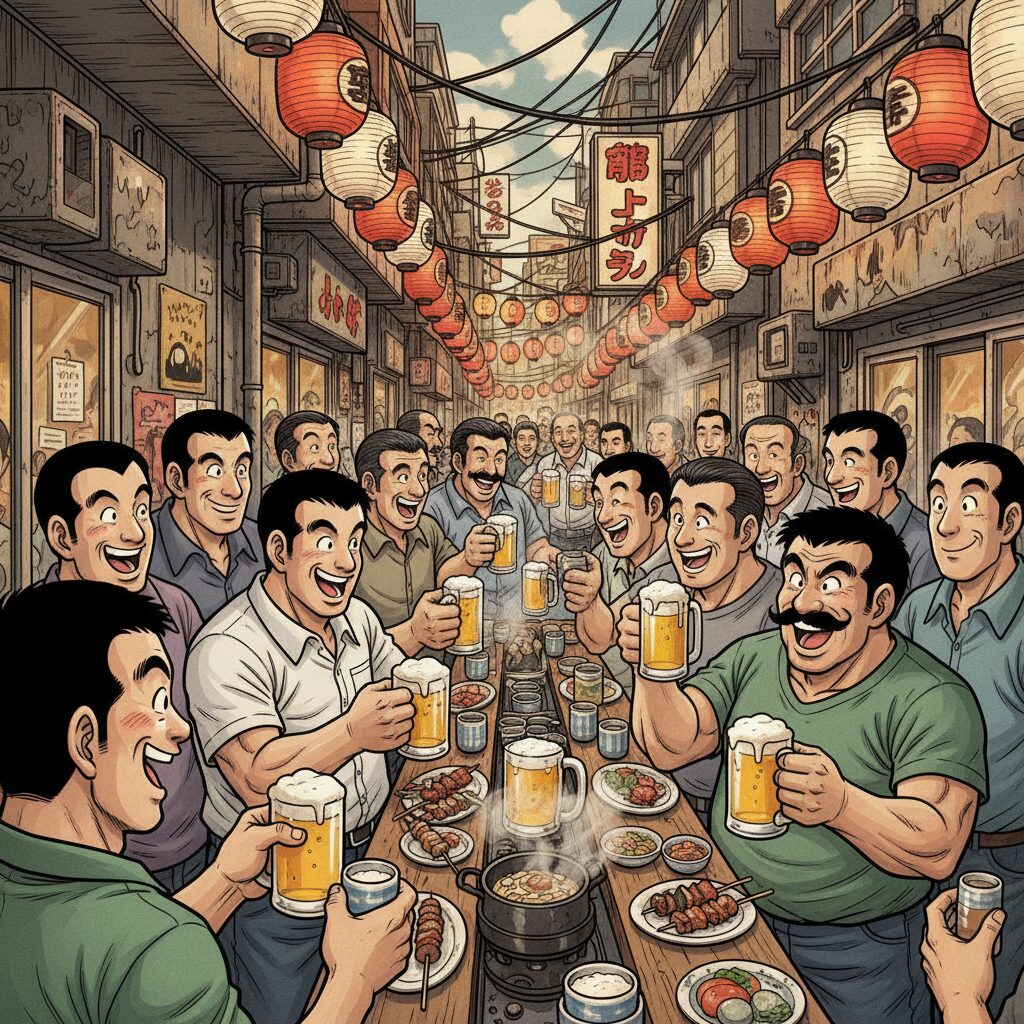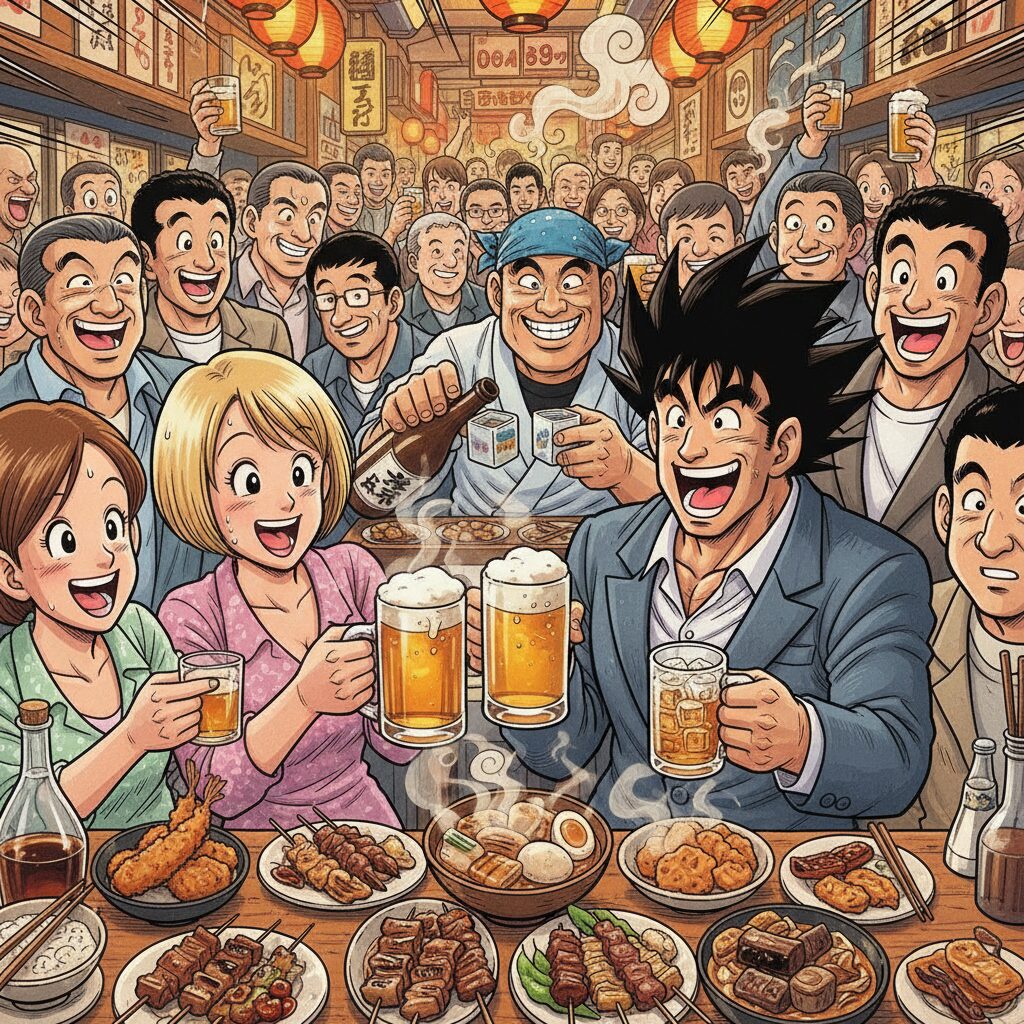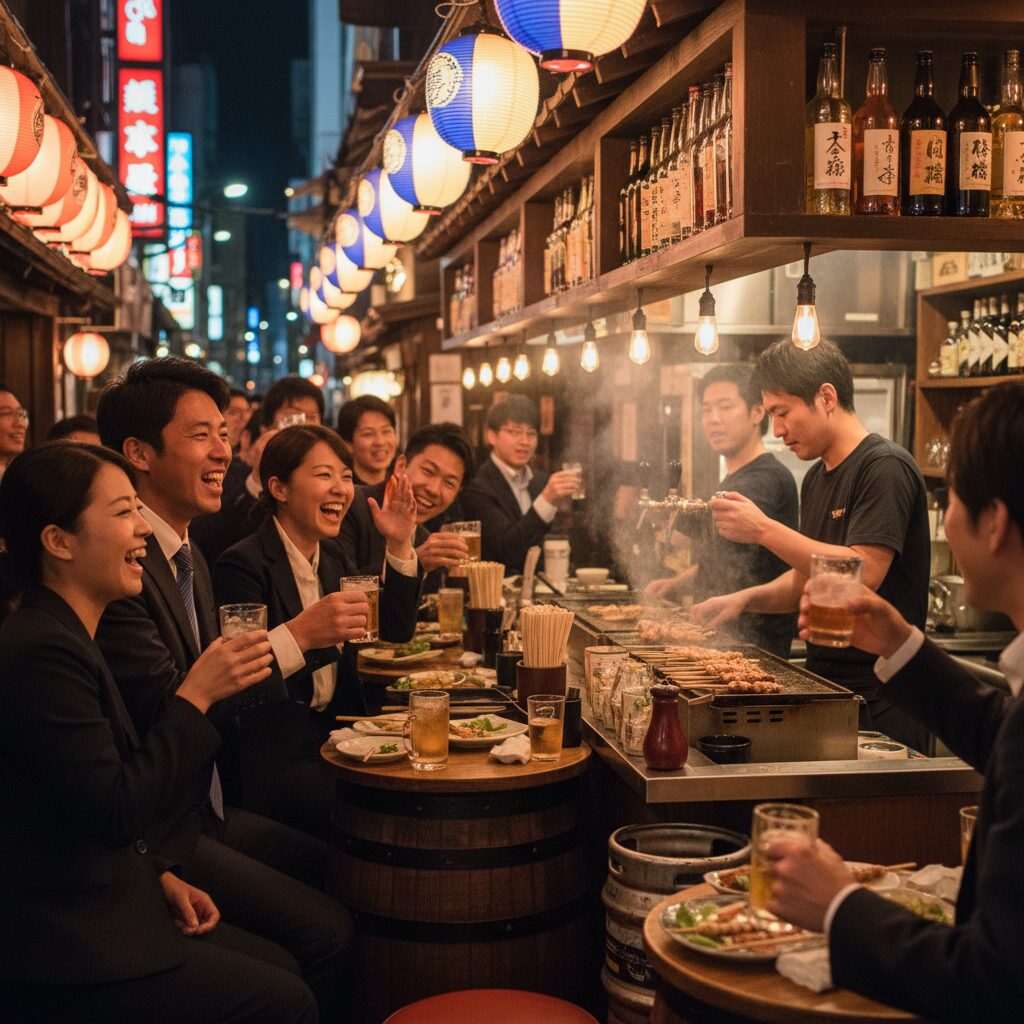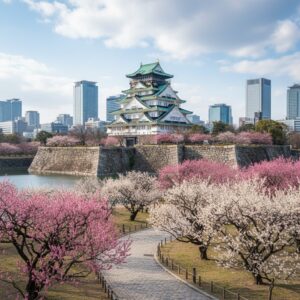Forget the choreographed perfection of guidebooks, the polished temples, and the neon-drenched tourist boulevards of Dotonbori. There is another Osaka, a city that truly awakens when the office lights dim and the neckties are loosened. It’s a world that exists in the steam-filled alleyways and under the rumbling train tracks, a world powered by cheap beer, grilled meats, and the cathartic release of a long day’s work. This is the world of the Japanese salaryman, and its spiritual home is a gritty, sprawling, beautiful mess of a neighborhood called Kyobashi. This isn’t a place you’ll find on a typical itinerary. Kyobashi is a transportation hub, a frantic confluence of steel rails and rushing commuters, but for those in the know, it’s a portal. It’s a gateway to one of Japan’s most authentic and exhilarating cultural experiences: the tachinomi, or standing bar. Here, for the price of a few coins, you can drink shoulder-to-shoulder with the men and women who build this nation’s economy, sharing in a ritual that is as integral to Japanese life as any tea ceremony. This is your guide to stepping through that portal, to navigating the unwritten rules, and to finding a genuine connection in the warm, boisterous, and wonderfully real world of Kyobashi’s standing bars.
The Soul of Kyobashi: Why This Gritty Corner of Osaka Matters

Kyobashi doesn’t try to dazzle you. It lacks the architectural grandeur of Umeda or the vibrant, Blade Runner-inspired energy of Namba. Its charm is subtler, more deeply rooted. It’s a neighborhood that feels well-lived, its character engraved in the smoke-stained walls of tiny bars and the weathered faces of their owners. Roaming through its covered shopping arcades, the shotengai, and venturing into the narrow alleys branching off them, is like stepping back in time. Here, the authentic Osaka lets its guard down, far from the lens of tourist cameras.
A Gateway to Showa-Era Nostalgia
Much of Kyobashi’s drinking district resembles a perfectly preserved film set from the Showa Era (1926-1989), Japan’s post-war economic boom period. This era shaped the modern salaryman image: grueling work hours, unwavering company loyalty, and the essential after-work drinking sessions called nominication (a blend of nomu, meaning to drink, and communication), used to bond with colleagues and clients. The tachinomi bars that thrived during this time were designed for one purpose: to serve cheap, satisfying food and drinks quickly and efficiently to a massive workforce. The vibe remains intact. Imagine bare concrete floors, mismatched stools if there are seats at all, walls plastered with yellowed, handwritten menus listing items for just a few hundred yen, and vintage ads for Sapporo or Asahi beer featuring models sporting bygone hairstyles. The air is heavy with the scent of sizzling pork, sweet simmering miso, and a faint haze of cigarette smoke, all underscored by the steady clatter of JR Loop Line trains passing overhead. This ambiance isn’t a retro theme; it’s the authentic article, a tribute to a lifestyle that has endured for decades.
The Great Equalizer: Where Rank and Title Vanish
Within the strict hierarchy of a Japanese office, every interaction follows status, age, and position. But a magical change occurs when you step beyond the noren curtain of a tachinomi. Inside, the corporate ladder disappears. A senior department head, the bucho, might be sharing a laugh with a fresh-faced new recruit, their shoulders nearly touching in the cramped space. This is a refuge for honne, the Japanese term for one’s true feelings and desires, in contrast to tatemae, the public facade upheld in polite or professional settings. Beer and highballs serve as social lubricants, dissolving the day’s formalities. Conversations become louder, more candid, and laced with the well-known Osaka humor. This is the heart of the Kyobashi tachinomi experience. It’s not just about drinking; it’s about witnessing and joining in a moment of genuine human connection—a place where people can truly be themselves. For a traveler, it offers an unmatched chance to glimpse the real Japan, free from formalities and buzzing with raw, unfiltered life.
Decoding the Tachinomi Experience: An Insider’s Playbook
At first sight, the bustling chaos of a crowded Kyobashi tachinomi can feel overwhelming. Dozens of conversations happen simultaneously, the master shouts orders, and regulars move with practiced ease. Yet, like any intricate system, there is a distinct logic and rhythm to it. Learning the unwritten rules is key to unlocking this world, transforming you from a tentative observer into a confident participant.
Finding Your Spot: The Art of the Kyobashi Bar Crawl (Hashigo-zake)
The authentic Kyobashi experience isn’t about settling in one bar all night. The aim is to practice hashigo-zake, which literally means “ladder drinking,” more commonly known as bar crawling. The idea is to enjoy one or two drinks and a small dish at one place before moving on to the next, sampling each venue’s unique vibe and specialties. This keeps the energy vibrant and lets you explore the area’s remarkable variety. Begin your journey at the East Exit of JR Kyobashi Station, the starting point. Let your senses lead the way—look for glowing red lanterns, or akachochin, marking izakayas or bars. Follow the scent of grilled eel or the burst of lively laughter escaping an open door. You’ll find bars that are little more than counters built under the train tracks, specializing in sizzling horumon (grilled offal). Others are legendary fishmongers by day, serving incredibly fresh sashimi at rock-bottom prices from improvised counters at night. Some focus on kushikatsu (deep-fried skewers), others on steaming pots of oden, and a few seem powered purely by their owner’s magnetic personality. The thrill is in the discovery—don’t overthink it. If a spot catches your eye, give it a try.
The Unwritten Rules: Tachinomi Etiquette for the First-Timer
Navigating your first tachinomi is a delicate dance, and knowing the steps makes all the difference. When you find a spot you like, pause at the entrance. Check for an open seat at the counter. Don’t just push your way in. Make eye contact with the master (taisho) or staff member. A gentle nod and a gesture toward the space is usually enough. If it’s full, they’ll let you know, and you can move on to the next place. Once you’ve claimed your spot—a small section of the counter that’s yours for now—respect it. Keep your bag at your feet or on a provided hook, and avoid sprawling your elbows into your neighbor’s space. Many tachinomi run on a cash-on-delivery system, or daikin-hikikae. You’ll often see a small tray or bowl on the counter before you—that’s where you place your money when ordering. It’s best to have plenty of 1,000 yen notes and coins. The staff will collect the payment and return your change in the same tray. This efficient system supports a quick turnover of customers. When it comes to starting conversations, it’s usually best to wait for a natural moment. Locals often take an interest in foreigners among them. A simple smile can open doors. After a drink or two, the atmosphere relaxes. If you overhear neighbors chatting about a dish, feel free to join in with an “Oishisou desu ne!” (That looks delicious!). The most important rule is to read the room. Tachinomi are designed as transient spots—pit stops where you have a few drinks, a quick bite, and then move on. Lingering for hours over a single beer is frowned upon. When it’s time to leave, saying “Gochisosama deshita” (a polite thank you for the meal and drinks) to the master is the perfect way to wrap up your visit.
A Symphony of Sips and Snacks: What to Order in a Kyobashi Tachinomi

The menus in Kyobashi celebrate food that is straightforward, richly flavorful, and thoughtfully designed to complement alcohol perfectly. Don’t expect delicate nuances; this is hearty food full of character and boldness. Even if you can’t read a single character on the hand-written menu, you can always succeed by pointing to what your neighbor is having and saying, “Sumimasen, onaji no kudasai” (Excuse me, the same one please).
The Holy Trinity of Drinks: Beer, Highball, and Sake
The first drink of the evening is almost always a nama biru, a draft beer. The Japanese beer pour is something of an art, creating the perfect head of foam, and nothing refreshes after a long workday quite like that first cold, crisp sip. After that, the salaryman’s preferred drink is the highball—a simple mix of Japanese whisky and super-carbonated soda served in a tall glass filled with ice. It’s the ultimate session drink: refreshing, affordable, and potent. While some places use a soda gun, the best will serve high-quality whisky with bottled soda for a superior fizz. Of course, there is always nihonshu, or sake. Don’t hesitate to try it. You can order it hot (atsukan) or cold (hiya), typically served in a small flask called a tokkuri with tiny cups. Many bars offer a reasonably priced house sake. For a stronger option, try shochu, a distilled spirit made from sweet potatoes, barley, or rice. Osakans often drink it diluted with hot water (oyuwari) or cold water (mizuwari).
The Perfect Pairing: Essential Tachinomi Appetizers (Ate or Tsumami)
The food, known as ate or tsumami, is just as vital as the drink. Look out for doteyaki, a slow-cooked stew of beef sinew and konjac jelly in a rich, sweet white miso broth. It’s a signature Osaka dish, with each bar boasting its own secret recipe. It’s incredibly tasty, melting in your mouth with a savory depth that will have you ordering another drink right away. Kushikatsu are skewers of meat, vegetables, and seafood, breaded in panko and deep-fried to a golden crisp. They come with a communal pot of thin, savory dipping sauce. The cardinal rule, followed with near-religious fervor, is absolutely no double-dipping. Dip your skewer once, and only once. If you need more sauce, use the provided slice of cabbage to scoop some onto your plate. In colder months, you’ll find large, steaming pots of oden. This is Japanese comfort food at its best: various ingredients like daikon radish, hard-boiled eggs, fish cakes, and tofu pouches simmered for hours in a light, flavorful dashi broth. You simply point to the items you want, and the chef will pick them out for you, often with a dab of sharp karashi mustard on the side. Many places also serve incredibly fresh sashimi or simply grilled fish, showcasing the quality of ingredients available even in casual settings. And don’t overlook the simple classics: a bowl of salted edamame, a small dish of Japanese-style potato salad, or something more adventurous like shiokara (fermented squid guts), a salty, pungent delicacy that’s an acquired taste but pairs perfectly with a crisp, dry sake.
Beyond the Bar Counter: The Human Element of Kyobashi
While the food and drink are a major attraction, what will truly linger with you long after you’ve left Kyobashi are the people. This offers a chance to engage with Japanese society on a level that most tourists never experience, sharing a moment of genuine humanity in a space created exactly for that purpose.
The Master (Taisho) of the House
At the heart of every great tachinomi is the master, or taisho. This individual embodies the spirit of the establishment. They might be a gruff-looking older man who has stood behind the same counter for forty years, or a cheerful woman who knows every regular by name. They are the conductors of the symphony, simultaneously taking orders, pouring drinks, cooking food, and maintaining the social harmony of the bar. They are repositories of local knowledge and have witnessed it all. Although often busy, a polite compliment on the food or a simple thank you can earn you a warm nod or even a smile. Watching them at work is a performance in itself—a masterclass in efficiency and subtle hospitality.
Breaking the Ice with the Regulars (Jouren)
The idea of talking to locals might seem intimidating, but it’s easier than you think, especially in Osaka. The people of Osaka have a well-earned reputation for being more outgoing, humorous, and direct than their Tokyo counterparts. They often take pride in their city and culture, and genuinely appreciate when a foreign visitor makes an effort to experience it. Don’t try to force a conversation; let it unfold naturally. If someone asks where you’re from, respond with a smile. If they recommend a dish, give it a try. A great way to connect is to offer to buy someone a drink, a gesture that is almost always welcomed and often returned. Ask about their favorite Hanshin Tigers player, or which bar you should visit next on your hashigo-zake tour. You might be surprised by the kindness and generosity you receive. These interactions turn a simple night out into a treasured travel memory, the stories you’ll share for years to come.
Practical Navigation for Your Kyobashi Adventure

A bit of practical knowledge will help ensure your journey into the heart of salaryman nightlife goes smoothly and enjoyably. Kyobashi can be overwhelming, but with a few tips, you’ll be able to navigate it like a local.
Getting There and Finding Your Bearings
Kyobashi Station is one of Osaka’s key transportation hubs, making it very accessible. It is served by the JR Osaka Loop Line, the JR Tozai Line, the Keihan Main Line, and the Nagahori Tsurumi-ryokuchi Subway Line. This means you can reach it directly from major areas like Osaka/Umeda, Tennoji, and even from Kyoto via the Keihan line. To find the prime drinking area, exit the station on the east side, away from the large modern Keihan Mall. The JR East Exit will bring you right to the entrance of the main shotengai, the covered arcade. This is your starting point. While the arcade has many excellent spots, the real gems are often hidden in the smaller alleys branching off from it, especially those running underneath the elevated train tracks. Allow yourself to get a bit lost; that’s where the best discoveries await.
Timing is Key: When to Dive into the Nightlife
To experience Kyobashi at its best, align your schedule with the salaryman’s routine. The prime time is between 5:30 PM and 8:00 PM on a weekday. This is when bars are buzzing with energy, filled with workers fresh from the office. Counters will be crowded, conversation lively, and the atmosphere at its peak. Arriving slightly earlier, around 5:00 PM, is a good strategy to secure a spot before the main rush. While weekends are an option, the crowd differs—more shoppers, couples, and younger groups. For the true salaryman vibe, Tuesday, Wednesday, or Thursday evenings are ideal. It’s worth noting that many tachinomi open early, some as soon as noon, serving retirees, shift workers, and those taking a break from work. An afternoon drink in Kyobashi offers a more relaxed, mellow atmosphere—a different but equally intriguing experience.
A Word on Language and Payments
Don’t let language barriers discourage you. While English is rare or absent on menus and among staff, it’s not an insurmountable challenge. Your best tools are a smile, a point, and a few key phrases. “Kore o kudasai” (This one, please) while pointing at a dish will get you fed every time. “Nama biru, onegaishimasu” will get you a beer. And a cheerful “Oishii!” (Delicious!) is a universally appreciated compliment. Keep in mind this is a cash-based culture. Very few, if any, small traditional bars accept credit cards. Come prepared with a wallet full of 1,000 and 5,000 yen notes, plus some coins. This will make transactions smooth and show that you’re ready.
A Final Toast to Authenticity
A night out in Kyobashi is far more than just a casual bar crawl. It offers an immersive cultural experience—a lesson in modern Japan’s history, a window into the social dynamics shaping its society, and an opportunity to connect with people on their own terms, within their own space. It’s a journey that invites you to step outside your comfort zone, embrace the unfamiliar, and rely on the universal language of shared meals and raised glasses. It reveals that beneath the reserved exterior of the Japanese salaryman lies a world full of warmth, humor, and a profound appreciation for life’s simple pleasures. So, when you find yourself in Osaka, be bold. Take the train to Kyobashi. Seek out a glowing red lantern, take a deep breath, and step beyond the cloth curtain. A seat at the counter, a cold drink, and an authentic piece of Japan’s spirit await you.



